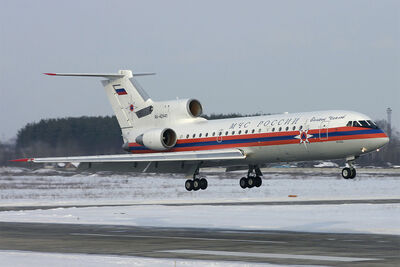
The Yakovlev Yak-42 (NATO reporting name: "Clobber") is a 100/120-seat three-engined mid-range passenger jet. It was designed as a replacement for several obsolete Aeroflot jets as a mid-range passenger jet. It was also the first airliner produced in the Soviet Union to be powered by modern high-bypass turbofan engines.
Design and development[]
In 1972, the Yakovlev design bureau started work on a short to medium range airliner capable of carrying 100–120 passengers. It was intended to be a replacement for the Tupolev Tu-134 jet as well as the Ilyushin Il-18, Antonov An-24 and An-26 turboprop airliners. While the new airliner was required to operate out relatively small airfields while maintaining good economy, as many Soviet airports had been upgraded to accommodate more advanced aircraft, it did not have to have the same ability to operate from grass strips as the Yakovlev's smaller Yak-40. The requirement resulted in the largest, heaviest and most powerful aircraft designed by Yakovlev so far.
Initial design proposals included a straight-wing airliner powered by two Soloviev D-30 turbofans and resembling an enlarged Yak-40, but this was rejected as it was considered uncompetitive compared to Western airliners powered by high bypass ratio turbofans. Yakovlev settled on a design powered by three of the new Lotarev D-36 three-shaft high bypass turbofans, which were to provide 63.90 kN (14,330 lbf) of thrust. Unlike the Yak-40, the new airliner would have swept wings.
The Yak-42 is a low-winged monoplane of all metal construction, with a design lifespan of 30,000 one-hour flights. It has a pressurised fuselage of circular sectio

n, with the cabin designed to carry 120 passengers in six abreast layout (or 100 passengers for local services with greater space allocated to carry-on luggage and coat stowage). The aircraft is flown by a flight crew of two pilots sitting side-by-side in a flight deck forward of the cabin. Access is via two airstairs, one in the underside of the rear fuselage, like that of the Yak-40, and one forward of the cabin on the port side. Two holds are located under the cabin, carrying baggage, cargo and mail.
The wing layout underwent considerable revision during the design process, with the first prototype being built with a wing sweep of 11 degrees and the second prototype with a sweep of 23 degrees. After evaluation, the greater sweep of the second prototype was chosen for production. Early aircraft had a clean wing leading edge with no control surfaces, and plain trailing edge flaps. This changed in later aircraft, which were fitted with leading edge slats, with the trailing edge slats slotted.
Two engines were mounted in pods on either side of the rear fuselage, with the third embedded inside the rear fuselage, fed with air via an "S-duct" air inlet. An auxiliary power unit (APU) is also fitted in the rear fuselage. No thrust reversers are fitted. The aircraft has a T-tail, with both the vertical fin and the horizontal surfaces swept.